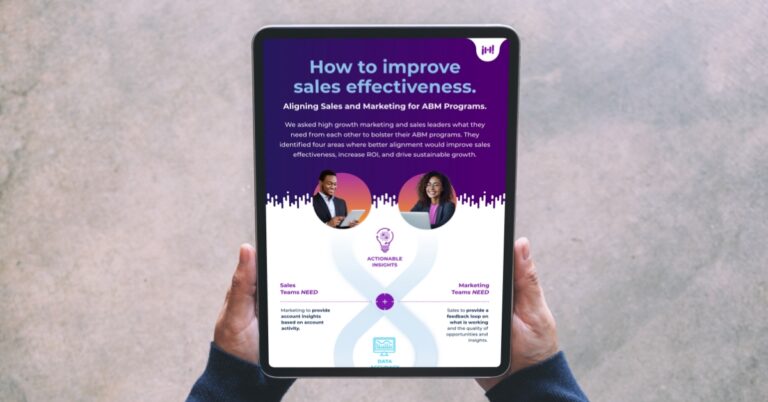In the ever-evolving landscape of B2B marketing, we’re constantly seeking innovative strategies to target, engage, and close high-value customers. By far, the most popular approach to have emerged in recent years is account-based marketing (ABM).
But adopting and implementing ABM has proven to be challenging for many B2Bs. So, let’s dive into the fundamentals of ABM and explore its key principles for success, as well as the transformative impact it can have on your B2B marketing and sales efforts.
ABM is a highly personalized and targeted B2B marketing approach that flips the traditional marketing funnel. Instead of casting a wide net to attract a broad audience, ABM identifies a select group of high-value accounts (companies) and targets key decision-makers on the buying teams within those accounts.
Imagine you’re hosting a dinner party, and you’ve carefully selected a few VIP guests (decision-makers) you really want to impress. Before your guests arrive, you’ve thoroughly researched their unique needs, challenges, and goals, allowing you to create specialized content and messaging that specifically address their distinct requirements, like tailoring your dinner menu to your guests’ preferences.
ABM is about engaging with your best-fit accounts on a personal level, providing a customized experience that shows you genuinely understand and care about their specific concerns, which significantly increases the likelihood of converting them into customers.
Why should B2B organizations use ABM?
In a market bombarded by generic marketing noise, ABM cuts through the clutter, offering a more efficient, focused, and impactful way to win over the accounts that truly matter to your business.
Here’s why:
- Precision. First, instead of spreading your attention thin across a wide pool of potential prospects, ABM shifts your focus to specific high-priority accounts. This saves time and resources because you’re directing your efforts where they will make the most impact.
- Personalization. Second, ABM fosters stronger, more meaningful relationships with each individual on the buying team through content and messaging tailored to their specific needs. You’re creating a conversation where you’re truly able to connect with each buyer because you understand the unique role they play within their organization and can speak to their pain points and business goals.
- Path to purchase. Third, ABM maximizes conversion and return on investment (ROI) because you’re not playing the numbers game, casting a wide net and hoping for best results; instead, you’re strategically courting prospects who are most likely to convert with highly relevant content and messaging that deeply resonates with them. Therefore, ABM not only helps you identify your dream customers, it also gives you a roadmap for nurturing relationships effectively to streamline the sales cycle.
What are the different types of account-based marketing strategies?
ABM strategies can be categorized into different types based on their focus, approach, and scale—but always keep in mind: ABM is akin to custom-fitting your marketing strategy for a select VIP guest list rather than hosting an open house for the public.
1:1 ABM.
This strategy entails thorough research on a single, high-value account, including its goals, pain points, and decision-making processes. The information is then used to create personas that detail the roles and preferences of key individuals within the target account. Marketing and sales are now equipped to tailor content and messaging for each persona, which optimizes personalization and engagement.
1:few ABM.
In this approach, marketing and sales efforts are tailored for a small, but still relatively narrow group of high-value accounts. The idea is to group together accounts that share similar characteristics to allow for some efficiency in terms of resource allocation. While not every account is identical, there may be enough commonalities among certain groups to make a personalized approach feasible.
1:many ABM.
This strategy optimizes efficiency while still maintaining a more personalized touch than a broad-based demand gen approach. It involves scaling up marketing and sales efforts to target a large group of high-value accounts. But rather than crafting entirely individualized campaigns, focused messages and content are applied to the entire account segment, which strikes a balance between personalization and scalability.
Programmatic ABM.
This method leverages technology, including artificial intelligence (AI), to scale and optimize the ABM process. Programmatic ABM is about automating processes like ad targeting, content personalization, and campaign optimization, transforming manual efforts into a more streamlined and scalable framework. This enables marketing and sales teams to efficiently reach a large audience while maintaining a degree of personalization.
Choosing the right ABM strategy depends on factors such as business goals, resources, and the level of personalization required for target accounts. But you can use a combination of these strategies to create a comprehensive and effective ABM program.
What is the difference between ABM and demand generation?
The choice between ABM and demand generation depends on your business goals, target audience, and the level of personalization desired. For most marketing organizations, it isn’t a matter of using ABM or demand gen, but carefully planning how to use the two strategies together. Here are the main differences between them.
Focus.
ABM concentrates on specific, strategically important accounts. It’s about treating each account or group of accounts as a market of its own and tailoring marketing and sales efforts to meet the unique needs of those accounts. It’s about quality over quantity, with the goal of building strong, lasting relationships with key decision-makers. Demand generation, on the other hand, is more broad-based. It aims to create awareness and interest among a large audience. The focus is on generating demand for a product or service across the market. The emphasis is on attracting a large volume of leads.
Personalization.
ABM involves marketing communication that is carefully crafted to resonate with the specific characteristics, goals, and pain points of key personas within target accounts. While personalization is still a consideration in demand generation (or it should be), it doesn’t reach the same level of individualization as ABM. In demand generation, the audience is diverse, and tailoring messages to suit each prospect’s unique characteristics is not feasible at such a scale.
Metrics and measurement.
Metrics in ABM are account-specific and focus on the depth and quality of the relationships with targeted accounts. Success is evaluated based on engagement and conversion of these high-value accounts. Metrics in demand generation include more traditional key performance indicators (KPIs) like lead generation, website traffic, and overall brand visibility. Success is usually measured by the volume of leads generated.
Sales and marketing alignment.
ABM necessitates close collaboration between sales and marketing teams. Both teams work together to identify, target, and engage high-priority accounts with a unified strategy. While collaboration is still essential in demand generation (again, it should be), it involves a more traditional handoff of leads from marketing to sales without the same level of account-specific collaboration.
What are the components of a successful ABM strategy?
Marketing and sales alignment.
Alignment at multiple levels, from the Chief Revenue Officer (CRO) down to demand gen teams, marketing ops, sales managers, and sales enablement is critical for the success of ABM.
However, it’s the collaboration between marketing and sales that’s foundational to an effective ABM program. It ensures a seamless and coordinated approach—from initial identification of target accounts to ongoing relationship building efforts—which ultimately leads to higher conversion rates and more meaningful, long-term partnerships with key accounts.
Unified strategy.
A unified and coordinated effort ensures that everyone is working toward common goals and objectives. For example, marketing can provide sales with relevant insights and data about an account’s interactions at specific touchpoints. Then, sales can pick up the conversation at any point throughout the customer journey with a deep understanding of the account’s needs and preferences.
Identifying target accounts.
Sales, having direct interactions with potential customers, possesses unique insights into the specific details of strategically important accounts. Involving your sales team in the selection process ensures a more comprehensive understanding of target accounts and, consequently, more personalized messaging.
Personalization.
ABM relies heavily on tailoring messages and content to the specific characteristics of the buying team within target accounts. Marketing and sales teams working together can combine qualitative feedback from sales interactions with quantitative data from marketing efforts to create highly customized and relevant communication strategies that create a meaningful dialogue with each persona.
Nurturing relationships.
Marketing’s role in ABM includes leveraging various channels to engage buyers at target accounts. As these interactions unfold, marketing collects data on how the account responds, what content they engage with, and how they progress through the sales funnel. This data is a goldmine of insights that provide a nuanced understanding of the buying team. When sales takes over, armed with this rich data, they can approach conversations with a comprehensive view of the buying team’s preferences, history, and engagement patterns.
Content creation.
While marketing traditionally takes the lead in content creation, the collaborative effort of marketing and sales brings a more comprehensive approach to crafting personalized content. Sales, being in direct communication with prospects, has firsthand knowledge of the questions, objections, and preferences that arise during interactions. Sharing these insights with the marketing team provides them with a deeper understanding of the specific needs of target accounts, which allows for more customized content creation.
Feedback loop.
Establishing a feedback loop of communication between marketing and sales allows for a continuous exchange of insights. For example, sales can provide valuable real-world feedback on the effectiveness of specific marketing strategies, which allows marketing to make real-time adjustments and promptly address any challenges or capitalize on emerging opportunities during an ABM campaign.
Measurement and reporting.
Both teams must agree on key performance indicators (KPIs) and metrics to ensure a cohesive, data-driven approach. By maintaining a unified understanding of performance metrics, both teams can align their efforts toward shared goals. Marketing gains insights into how their initiatives contribute to overall sales objectives, while sales benefits from having a comprehensive view of engagement levels, content effectiveness, and knowing where buyers are in the funnel.
Efficient use of resources.
Tight alignment prevents duplication of efforts. With a clear understanding of each other’s roles and responsibilities, marketing and sales can streamline their activities to make the most efficient use of time and resources.
Omnichannel strategy.
Omnichannel marketing is a comprehensive approach that integrates your marketing channels to create a seamless and unified experience for the audience across multiple touchpoints. Because ABM focuses on personalized interactions, omnichannel marketing allows marketing and sales to create tailored messages and content that deliver a cohesive brand experience, whether customers interact through online advertising, social media, email, or other channels. The holistic engagement provided by omnichannel marketing is instrumental in reinforcing your key messages and value propositions.
Account-level reporting.
The way data is managed in ABM should be specific. There needs to be a single source of analytical truth that both marketing and sales act upon. Opting for contacts and accounts over leads in your customer relationship management (CRM) system is a superior approach due to its organization and comprehensiveness.
Leads lack the structured information needed for effective ABM. Using contacts and accounts allows for enhanced segmentation, personalization, reporting, and data management—as well as more streamlined communication about account engagement between marketing and sales.
Integrated data and analytics.
Integrating your data sources and analytical tools provides your business with a comprehensive understanding of target accounts, their behavior, and the overall effectiveness of marketing and sales strategies. It also breaks down data silos, ensuring that information from various channels and platforms is interconnected to help your teams derive meaningful insights.
In ABM, integrated data and analytics play a crucial role in several aspects.
- 360-degree view of accounts. Integrated data allows marketing and sales teams to gain a holistic view of target accounts by consolidating information from multiple touchpoints. This includes data from CRM systems, marketing automation platforms, website interactions, social media, and more. Having a complete view enables better personalization and engagement strategies.
- Behavioral insights. By integrating data from various channels, marketing and sales can analyze the behavior of individuals within target accounts. This includes understanding which content they engage with, the frequency of interactions, and the channels through which they prefer to receive information. These insights help in tailoring content and communication to align with the preferences of the target accounts.
- Alignment of marketing and sales data. A unified view of data prevents silos by breaking down barriers between compartmentalized datasets. When marketing and sales data are aligned, it means that both teams are working with the same set of information and are able to create a shared understanding of the target accounts, including their interactions and intent.
- Attribution modeling. Integrated analytics allows marketing and sales to attribute conversions and successes back to specific strategies. This is vital in understanding the contribution of each touchpoint in the customer journey, which helps optimize targeting and personalization.
- Performance measurement: Leveraging data and analytics that are all connected provides a unified platform for measuring the performance of ABM campaigns. Metrics such as engagement rates, conversion rates, and ROI can be tracked across channels, allowing for data-driven decision-making and continuous improvement.
- Predictive analytics. Integrated data sets the foundation for accessing historical data and forecasting future patterns. Predictive analytics can help you identify potential high-value accounts, prioritize leads, and anticipate the most effective strategies for engaging target accounts.
Sales enablement.
ABM is a new way to go to market, requiring both marketing and sales to significantly change how and when they approach prospects. Here are five ways you can help ensure that your sales team has the tools they need to make your ABM program successful.
- Use a platform like Salesforce Sales Cloud and Hubspot Sales Hub to facilitate content sharing, sales communication, and analytics that can enhance the effectiveness of your sales efforts.
- Train both marketing and sales on how to use intent data, including navigating your intent platform, what signals to look for, and what actions to take.
- Provide templates in your marketing automation platform (MAP) or CRM that sales can easily customize for personalized outreach directed at high-intent buyers from target accounts.
- Leverage technology tools, such as AI-driven insights and predictive analytics, to empower your sales team with actionable information that can enhance their ability to navigate the complexities of account-based engagements.
- Employ change management strategies to foster sustained marketing and sales alignment.
What technology do I need for a successful ABM program?
Whether you’re utilizing the technology you already have or plan to purchase new technology, one thing is for sure: all your technology should be integrated, and data should be shared across all tools. Moreover, you should structure and format your data uniformly so that every team has the same information, regardless of where they are pulling reports.
Many organizations believe that getting their tech stack in order will require ripping out existing technology that doesn’t fit and inserting what does. That’s a bit of a fallacy. The key lies in a thoughtful and strategic tech stack evaluation to identify gaps and redundancies, and determine whether existing tools can be optimized or integrated with new solutions to meet your specific requirements. In many cases, organizations can leverage additional features or functionalities within existing technology rather than entirely discarding it.
While the specific components can vary based on your organizational needs and preferences, the following are some common elements found in a typical ABM tech stack.
Intent platform.
An intent platform allows you to identify accounts within your target account list that are currently in-market for your solution, and put relevant content in front of them. Common intent platforms include Demandbase, 6Sense, and Intentify.
It’s important to look for a platform that offers comprehensive coverage across relevant topics and industries. This increases the likelihood of identifying signals from accounts actively researching topics related to your solutions. Also, ask about the platform’s data sources, methodology, and the level of customization it provides, so you can tailor insights to your unique business needs.
CRM system.
A CRM is fundamental for managing and organizing customer data, facilitating collaboration between marketing and sales teams, and tracking interactions with target accounts. It serves as the central hub for information that informs personalized engagement strategies. Salesforce and HubSpot are the most popular CRM vendors.
When choosing a CRM, make sure it will align seamlessly with your ABM strategy and provide robust features for account management, lead tracking, and collaborative functionality. Ask about the CRM’s customization capabilities to ensure it can be tailored to the unique needs of your ABM campaigns and scale with the evolving complexities of your account-based marketing initiatives.
Marketing automation platform.
Marketing automation platforms (MAPs) streamline marketing processes, automate workflows, and enable the creation of targeted and personalized content for specific accounts. These platforms enhance the efficiency of marketing efforts and contribute to a more seamless execution of ABM campaigns. Several reputable vendors offer MAPs, including HubSpot, Marketo, Pardot (Salesforce), and Eloqua (Oracle).
Ensure that the platform you choose offers robust features for personalized content creation, targeted messaging, and seamless integration with your overall ABM strategy. Ask about the platform’s capabilities in account segmentation, lead scoring, and automated workflows that can be tailored to the complexities of your ABM campaigns.
Account-based advertising tools.
Targeted advertising is a key element of ABM, and specialized tools for account-based advertising help in delivering tailored messages to specific accounts. Key vendors in the account-based advertising space include Demandbase and 6sense.
When considering an account-based advertising vendor, look for the tech tool that provides precise targeting capabilities, enabling you to reach specific accounts with personalized and relevant content across various channels. Also, ask about the tool’s account identification methods and the extent of its integration with your broader ABM tech stack, such as your CRM and MAPs.
Personalization tools.
Personalization tools like Intellimize allow you to serve up different messaging, content, and experiences on your website based on visitor information—including visitors from your target accounts—such as engagement history, off- and on-property intent signals, and more.
Selecting the essential components of an ABM tech stack depends on the specific needs and objectives of your organization. However, I’ve prioritized the four components above as essential for a robust ABM strategy. While these components form a strong foundation, the importance of other tools—such as data management platforms, predictive analytics platforms, and sales enablement platforms—should not be overlooked. But choosing which essential components you need will vary based on your organization’s target audience and the complexity of your ABM strategy.
What data and analytics do I need to support my ABM program?
Measuring ABM ROI can be challenging, with difficulties often arising from poor tech stack integration, inadequate martech platform setup, and/or inappropriate metrics. But there’s no way around it: an effective ABM program requires that you understand and are able to communicate the value of your marketing and sales efforts in relation to your organizational goals.
To measure ABM ROI effectively, your focus areas should include readiness, activity, output, and impact.
- Readiness. Assessing readiness ensures that your organization is well-prepared and equipped to execute ABM initiatives successfully. This includes evaluating your teams’ capabilities and identifying any areas that may need improvement or additional resources.
- Activity. Measuring activity provides valuable insights into the efforts invested by both your marketing and sales teams. Tracking various interactions and engagement activities with target accounts helps gauge the quantity and quality of efforts directed toward key prospects.
- Output. Evaluating output is crucial for understanding the tangible outcomes of your ABM strategies, such as lead generation, conversions, and other specific results tied to your organization’s predefined goals.
- Impact. Focusing on impact involves assessing the overall influence of ABM on your business objectives. This entails going beyond the analysis of isolated metrics and individual results. Instead, your business should strive to gain a holistic view of the effectiveness of your overall ABM strategy, which is crucial for making informed decisions about how you should implement and refine your processes to optimize their impact on your business strategy.
Key reports for ABM.
There are five must-have reports that play a pivotal role in facilitating effective measurement of ABM ROI: (1) Account List, (2) Intent Data, (3) ABM Dossier, (4) Sales Motions, and (5) Planned vs. Actual. You can learn about each of these reports in more detail here.
The ultimate goal of these reports is to assess what’s working, what’s not, and why, enabling you to adjust marketing and sales motions in real time to maximize ABM ROI. Frequent review and accurate, up-to-date information are crucial for the success of these reports in accelerating opportunities with target accounts. Together, these reports create a robust and comprehensive framework for ABM ROI measurement and continuous improvement.
The Iron Horse insight.
ABM can significantly enhance your company’s customer relationships, pipeline quality, account retention, and overall revenue—regardless of your industry or company size. But successfully implementing ABM doesn’t require an immediate full-scale commitment. Pacing your ABM program according to your organization’s capabilities is essential. Consider launching a small-scale ABM program and then conduct a debrief with your marketing and sales teams, addressing questions such as the impact of precision targeting and personalization, and the effectiveness of different outreach methods. Then, apply these insights as you scale up.




